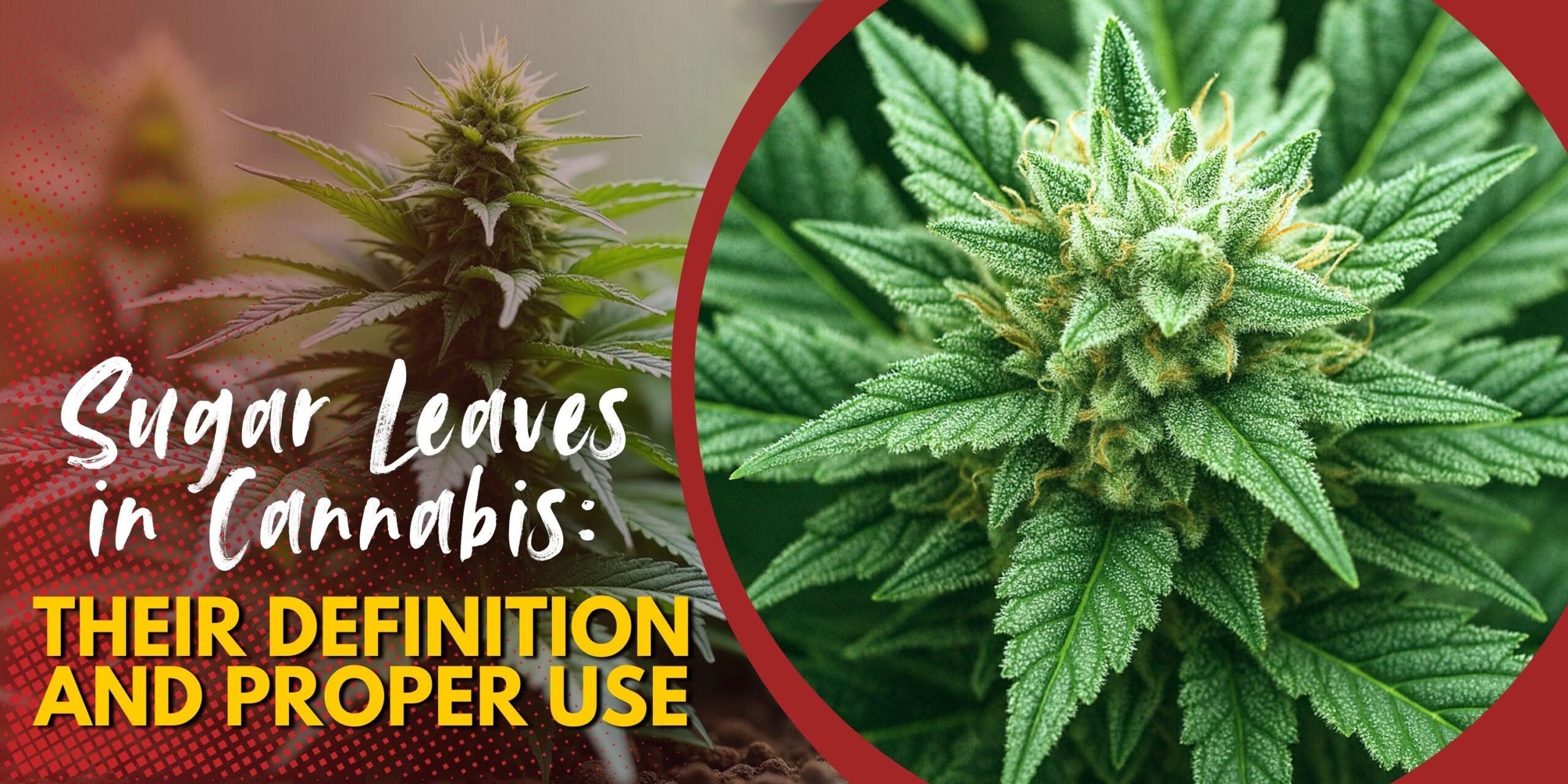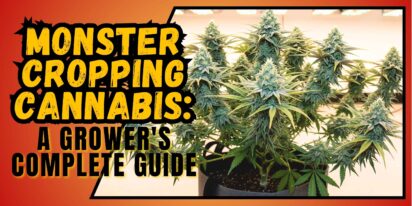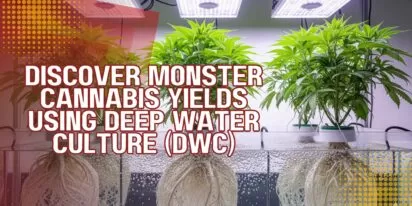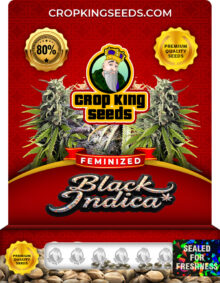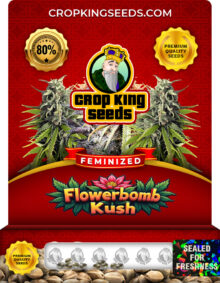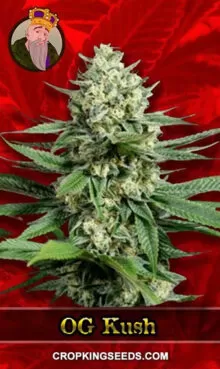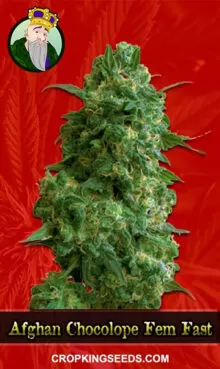Often disregarded as worthless by-products, sugar leaves have possible applications in edibles, concentrates, and even organic pesticides that make them rather relevant for any producer to consider. Putting sugar leaves to good use goes beyond the straightforward act of cutting them off; it can improve the quality of your cannabis experience both recreationally and therapeutically. Using all plant components, including sugar leaves, is a significant move towards a more sustainable grow cycle as sustainable and zero-waste growing techniques become more common in the cannabis sector.
What Are Cannabis Sugar Leaves?
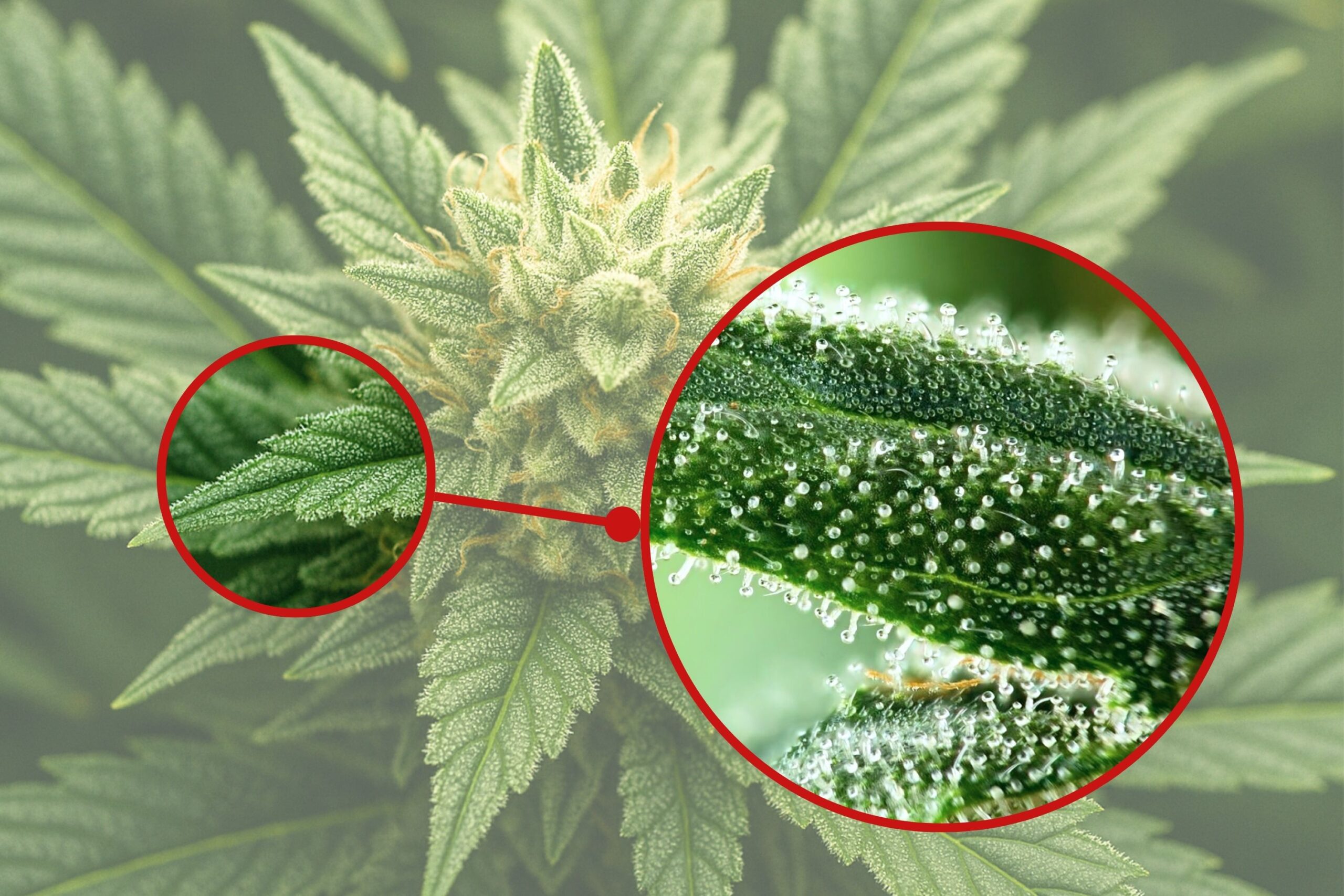
Emerging from cannabis buds are sugar leaves, which are tiny, thin leaves. Unlike fan leaves, the bigger leaves are mostly for vegetative-stage photosynthesis, while sugar leaves are trichome-covered and are part of the bud itself. Sugar leaves often have many cannabinoids and terpenes on them, so they appear frosted—hence the name “sugar” leaves.
Though not quite as cannabinoid-rich as the calyxes or the heart of the bud, sugar leaves can greatly increase the total strength of a harvest. Especially with tight indica strains, they are a natural extension of the bud structure and tend to become ingrained in it all through the flowering cycle. Based on eventual usage, growers will cut these leaves; those producing for edibles or concentrates can leave them intact; premium flower for smoking is often trimmed more cleanly.
Sugar Leaves vs. Fan Leaves: The Main Differences
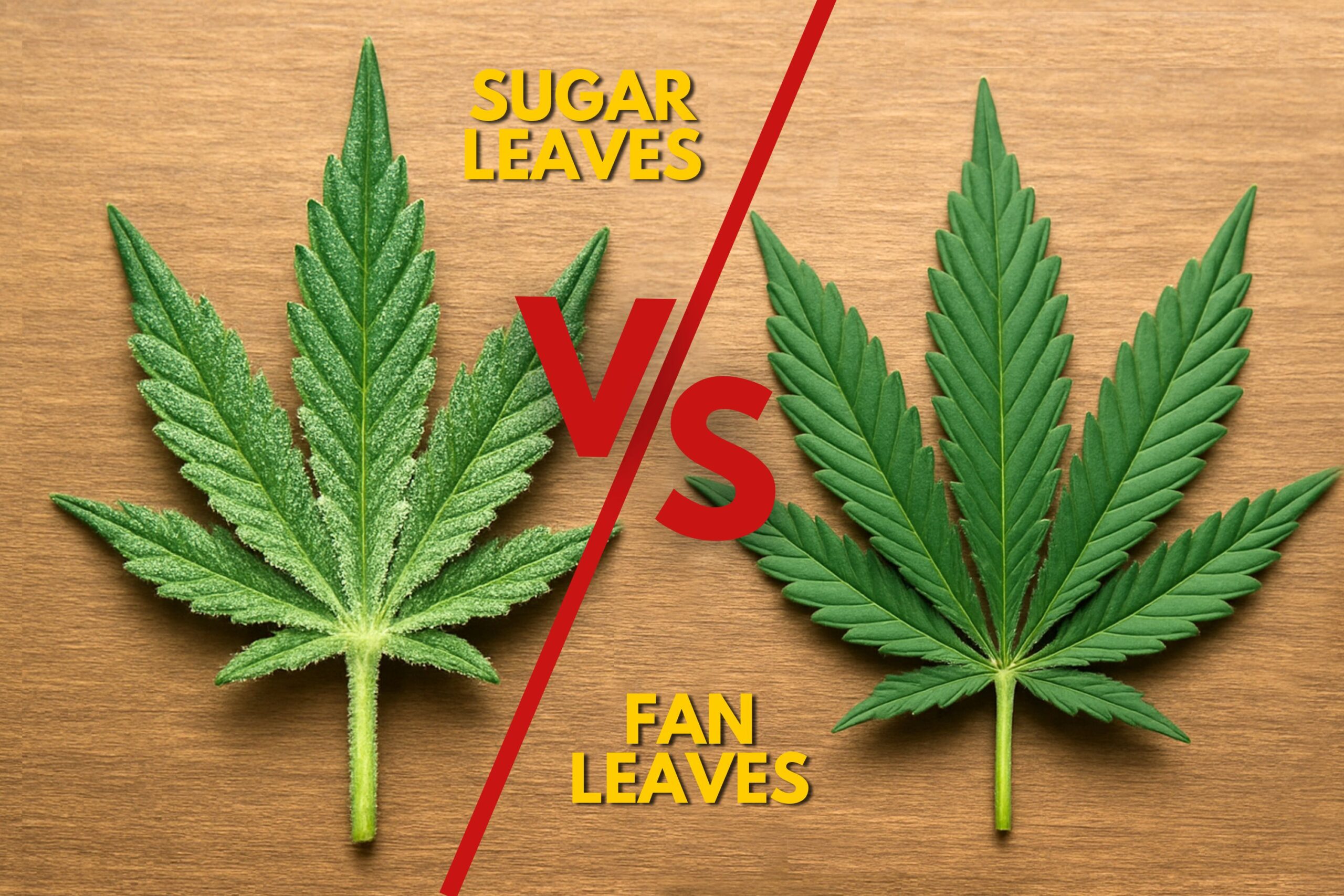
When comparing sugar leaves and fan leaves, one must first grasp how every component affects general plant health and post-harvest survival. Although fan leaves are often thrown away due to low THC content, sugar leaves are more useful as a source of cannabis extracts since they are full of trichomes. They also directly help produce resin from the plant, which may benefit both the farmer and the consumer.
As the name suggests, fan leaves are big, with a wide surface area meant to maximise photosynthesis. Usually poor in cannabinoids, these leaves have to energize the plant throughout the growing cycle. Conversely, while smaller, sugar leaves are quite resinous and a major source of cannabinoids, including THC and CBD. Sugar leaves’ trichome density makes them appropriate for usage in producing concentrates and in generating strong cannabis infusions.
Can You Smoke Sugar Leaves?
Though sugar leaf cannabis has a fair amount of cannabinoids, its smoking might not be the most enjoyable. The leaves usually have chlorophyll and other plant debris that makes the smoke more harsh than that from trimmed buds. Though not very harmful, most people find joints or bowls stuffed with sugar leaves to be less tasty and more throat-punishing.
However, if you cure them well and cut them precisely, you can still smoke or vaporize sugar leaves, especially when combined with some good buds. Use them cautiously or investigate alternative techniques for more effectively extracting their active components if you wish to gain their advantages.
Best Uses for Sugar Leaves After Harvest
1. Cannabutter and Edible Production
Sugar leaves are excellent for coconut oil or butter infusion. Being cannabinoid-rich, they provide a very strong infusion without compromising top-shelf cannabis. Your edibles are not just strong but also useful since decarboxylation activates the THC and CBD before infusion.
For savoury meals, biscuits, and brownies, sugar-leaf cannabutter is perfect. Because sugar leaves have less THC than buds, it simplifies the dosing, which is particularly useful for new users or those seeking lighter effects. Sugar leaf-infused edibles are, therefore, a great way to start using culinary cannabis and microdosing products.
2. Making Cannabis Concentrates:
Sugar leaves are also a great beginning material for many solventless and solvent-based concentrates. Among the most usual techniques are:
- Micron screens are used to mechanically separate trichomes in dry sifting.
- Resin heads are removed by agitating sugar leaves with icy water.
- Without solvents, heat, and pressure, extract cannabinoids.
During plant material extraction, both of these techniques preserve the therapeutic properties of the sugar leaves. Though still efficient and effective, concentrates made from sugar leaves are somewhat less powerful than those made from buds. Most hash producers mix sugar leaf material with tiny buds or “popcorn” nugs to improve productivity and general quality.
3. Making Cannabis Tea
Cannabis tea made from sugar leaves is soothing and mild. Combining the leaves with a fat product (like milk or coconut oil) during brewing increases strength since cannabinoids are not water-soluble.
For taste and synergistic benefits, chamomile, peppermint, or ginger, among other herbs, can be used to further improve this tea. Especially when made in the evening, sugar leaf teas are highly calming for those looking for anti-inflammatory or relaxing qualities. Sugar leaf tea can also be very beneficial for people who don’t smoke or who are sensitive to inhalation methods.
4. Mulching or Composting
Composting is a green option for people who have no desire to collect sugar leaves. They decompose nicely and enrich the compost pile with useful nutrients, which can then be used to modify the soil for the next harvest.
Sugar leaves’ nitrogen and organic content provide compost a jolt of microbial activity, increasing its capacity to feed the next cannabis crops. Growers dedicated to regenerative or organic farming can use composted sugar leaves as a closed-loop input, converting trash into living soil and lowering the cost of outside inputs.
How to Correctly Trim Sugar Leaves
Correct trimming of sugar leaves improves the bag attractiveness, strength, and smoke quality of the finished product. Whether you’re doing a wet or dry trim will greatly determine the trimming procedure. Preserving the strength of the plant material in both cases depends on the integrity of the trichomes.
Trimming Wet
Trimming right after harvest helps manage sugar leaves. The cuts might be neat; they haven’t had time to dry out and turn brittle. Wet trimming helps to avoid too much moisture getting trapped inside the buds as well, which helps to lower the frequency of mould and mildew. For farmers wanting to have the harvest processed and get on with drying, wet trimming is usually the preferred approach.
Drying Trimming
After allowing the entire plant or branch to dry, we perform dry pruning. Though it makes sugar leaves brittle and harder to trim, this technique lets trichomes stay intact longer. Dry trimming will usually produce a more powerful end product, though, since it lets the trichomes stay intact longer. It also reduces resin loss, which a well-cured plant can better hold.
Whether you decide to keep all trimmings for later processing is up to you. Handle sugar leaves carefully to maintain trichome integrity and use sharp, clean scissors or cutting equipment.
Sugar Leaf Storage Advice
Correct storage maintains the terpene and cannabinoid characteristics of sugar leaves:
- To prevent mold, store after complete drying.
- Store in a cool, dark area
- Use Integra or Boveda packs to track humidity and maintain RH at 58–62%.
Avoid storing sugar leaves in plastic bags or oxygen-breathing containers since these will let terpenes and cannabinoids deteriorate with time. Think about vacuum-sealing tiny amounts and freezing if you plan to store for long durations. The procedure reduces exposure to air and light, sealing in strength and scent until the item is ready for processing.
Whether you intend to use them in extracts, edibles, or topicals, appropriate storage keeps sugar leaves fresh for months. Maintaining quality and safety depends on regular checkups for mold, insects, or terpene losses.
Sugar Leaves’ Cannabinoid Content
While not as potent as the flowers, sugar leaves do have a quantifiable quantity of THC, CBD, and other minor cannabinoids. Depending on strain, growth conditions, and harvest time, it’s usually 10% to 20% of the strength of the surrounding buds.
Should I Keep Sugar Leaves?
That’s true. Ignoring sugar leaves is a wasted opportunity. These usually thrown-away portions of the cannabis plant provide great value, from high-end concentrates and strong edibles to therapeutic teas and nutrient-rich compost. Growers can get more sustainability, a better return on investment, and a larger product selection by turning sugar leaves into an asset instead of trash.
Sugar leaves have a rich variety of uses going far beyond basic extraction. Processed and preserved properly, they might form the foundation of a cannabis company for a farmer. Including sugar leaves in your business increases the possibility of your plant while minimising waste, hence producing a more sustainable and profitable cannabis-growing process.
Conclusion
Although sugar leaves may not be as visually appealing as hefty buds, their trichome-covered surfaces hold a wealth of information that is just waiting to be discovered. Ed. Sugar leaves have to fit into your post-harvest routine, whether you are a home grower trying to extend your harvest a little further or a commercial farmer aiming for zero waste processing. Gently clean them, dry them correctly, and convert them into premium derivatives that will raise your cannabis to fresh heights.





